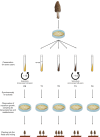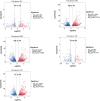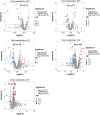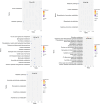Comparative transcriptomics and metabolomics provide insight into degeneration-related physiological mechanisms of Morchella importuna after long-term preservation
- PMID: 39887921
- PMCID: PMC11781861
- DOI: 10.1111/1751-7915.70045
Comparative transcriptomics and metabolomics provide insight into degeneration-related physiological mechanisms of Morchella importuna after long-term preservation
Abstract
Ascomycetes fungi are often prone to degeneration. Agricultural production of the prized ascomycete mushroom Morchella importuna (black morel) typically suffers from reduced yield and malformed ascocarps owing to culture degeneration. This study compared M. importuna cultures subjected to five different long-term preservation treatments, using transcriptomics and metabolomics. Avoiding repeated subculturing in combination with nutrient-limited conditions was found to be the most beneficial method for maintaining the fruiting capability of morels. The expression of the gene sets involved in cysteine and methionine metabolism and nucleocytoplasmic transport was upregulated under nutrient-limited and nutrient-rich conditions, respectively. This increased expression was accompanied by differential accumulation of metabolites involved in nucleobase metabolism. Repeated subculturing triggered dissimilar changes in the functional modules under nutrient-rich and nutrient-limited conditions. A diverse set of cellular biochemical processes related to carbon metabolism were altered by repeated subculturing under nutrient-rich conditions, whereas glycerophospholipid and purine metabolism were key functions affected by repeated subculturing under nutrient-limited conditions. Altogether, metabolic alterations related to sulfur-containing amino-acid biosynthesis, DNA repair, and cellular structural maintenance contributed to improved preservation outcomes in terms of morel fruiting capability. Our findings contribute to a more detailed understanding of the molecular mechanisms related to subculturing and fruiting of ascomycete macrofungi after long-term preservation.
© 2025 The Author(s). Microbial Biotechnology published by John Wiley & Sons Ltd.
Conflict of interest statement
The authors declare that they have no conflict of interest associated with this work.
Figures







Similar articles
-
Aroma-volatile profile of black morel (Morchella importuna) grown in Israel.J Sci Food Agric. 2018 Jan;98(1):346-353. doi: 10.1002/jsfa.8477. Epub 2017 Jul 28. J Sci Food Agric. 2018. PMID: 28597472
-
Transcriptomics combined with metabolomics unveiled the key genes and metabolites of mycelium growth in Morchella importuna.Front Microbiol. 2023 Feb 1;14:1079353. doi: 10.3389/fmicb.2023.1079353. eCollection 2023. Front Microbiol. 2023. PMID: 36819010 Free PMC article.
-
Multi-omic analyses of exogenous nutrient bag decomposition by the black morel Morchella importuna reveal sustained carbon acquisition and transferring.Environ Microbiol. 2019 Oct;21(10):3909-3926. doi: 10.1111/1462-2920.14741. Epub 2019 Aug 6. Environ Microbiol. 2019. PMID: 31314937
-
Artificial cultivation of true morels: current state, issues and perspectives.Crit Rev Biotechnol. 2018 Mar;38(2):259-271. doi: 10.1080/07388551.2017.1333082. Epub 2017 Jun 6. Crit Rev Biotechnol. 2018. PMID: 28585444 Review.
-
Mating Systems in True Morels (Morchella).Microbiol Mol Biol Rev. 2021 Aug 18;85(3):e0022020. doi: 10.1128/MMBR.00220-20. Epub 2021 Jul 28. Microbiol Mol Biol Rev. 2021. PMID: 34319143 Free PMC article. Review.
Cited by
-
Metabolic Influence of S. boulardii and S. cerevisiae in Cross-Kingdom Models of S. mutans and C. albicans.J Fungi (Basel). 2025 Apr 19;11(4):325. doi: 10.3390/jof11040325. J Fungi (Basel). 2025. PMID: 40278145 Free PMC article.
-
Integrated Transcriptomics and Metabolomics Provide Insight into Degeneration-Related Molecular Mechanisms of Morchella importuna During Repeated Subculturing.J Fungi (Basel). 2025 May 30;11(6):420. doi: 10.3390/jof11060420. J Fungi (Basel). 2025. PMID: 40558932 Free PMC article.
References
-
- Abdallah, R. , Rizk, I. , Hassan, A. & Elsheshetawy, H. (2021) A comparative study between different preservation methods on the viability of some yeast cultures. Arab Universities Journal of Agricultural Sciences, 29, 1–10.
-
- Aguilar, J.S. , Dulay, R.M.R. , Kalaw, S.P. & Reyes, R.G. (2024) Low‐cost preservation protocol for Lentinus mushrooms. Italian Journal of Mycology, 53, 99–109.
-
- Al‐Bedak, O.A. , Sayed, R.M. & Hassan, S.H.A. (2019) A new low‐cost method for long‐term preservation of filamentous fungi. Biocatalysis and Agricultural Biotechnology, 22, 101417.
-
- Ayala‐Zermeño, M.A. , Gallou, A. , Berlanga‐Padilla, A.M. , Andrade‐Michel, G.Y. , Rodríguez‐Rodríguez, J.C. , Arredondo‐Bernal, H.C. et al. (2017) Viability, purity, and genetic stability of entomopathogenic fungi species using different preservation methods. Fungal Biology, 121, 920–928. - PubMed
Publication types
MeSH terms
Grants and funding
- SCCXTD-2024-07/Sichuan Edible Mushroom Innovation Team of National Modern Agriculture Industry Technology System
- Sichuan Science and Technology Planning Project Key Research and Development Project (2021YFYZ0026)
- National Modern Agriculture Industry Technology System (CARS-20)
- Innovation 2035 Project of SAAS (YSCX2035-009)
- 1+9 Program of SAAS (1+9KJGG003)
- National Natural Science Foundation of China (NSFC31901119)
- National Scientific Observation and Experimental Station of Agro-Microorganisms, Xindu (NAES085AM05)
- Laboratory of Excellence ARBRE (ANR-11-LABX-0002-01)
- the Northwest Institute of Eco-Environment and Resources, and the Scientific and Technological Projects of Gansu Province (23YFFA0013)
LinkOut - more resources
Full Text Sources

